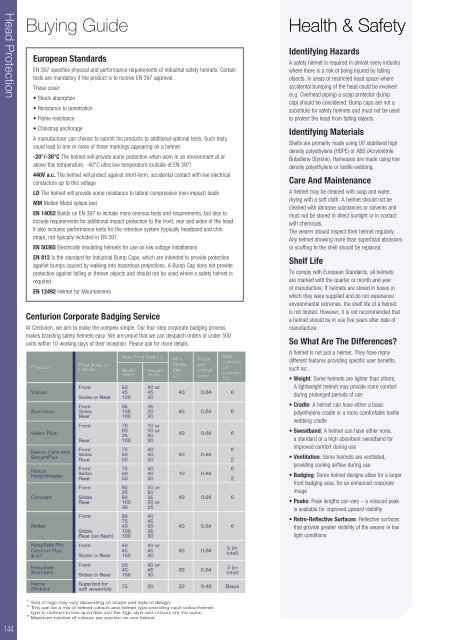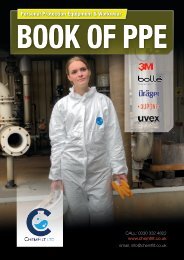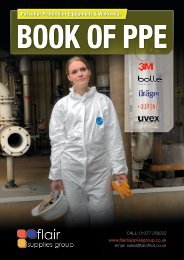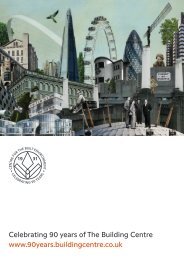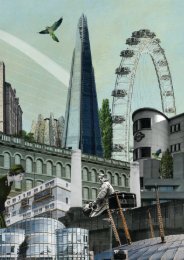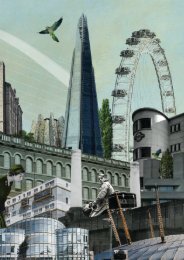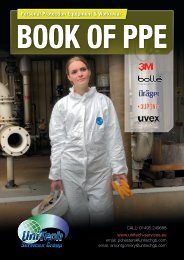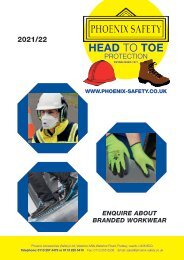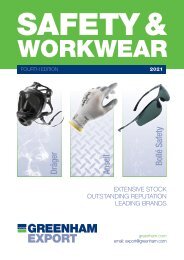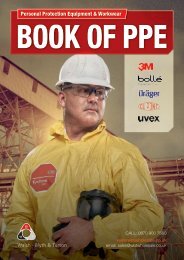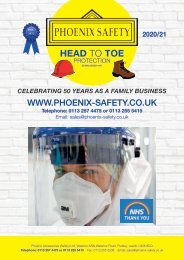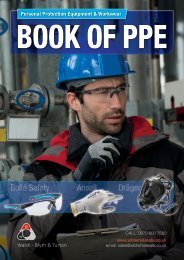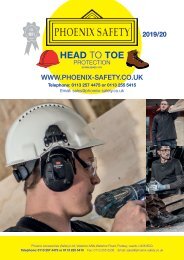Create successful ePaper yourself
Turn your PDF publications into a flip-book with our unique Google optimized e-Paper software.
Head Protection<br />
Buying Guide<br />
European Standards<br />
EN 397 specifies physical and performance requirements of industrial safety helmets. Certain<br />
tests are mandatory if the product is to receive EN 397 approval.<br />
These cover:<br />
• Shock absorption<br />
• Resistance to penetration<br />
• Flame resistance<br />
• Chinstrap anchorage<br />
A manufacturer can choose to submit his products to additional optional tests. Such tests<br />
could lead to one or more of these markings appearing on a helmet.<br />
-20°/-30°C The helmet will provide some protection when worn in an environment at or<br />
above this temperature. -40°C ultra low temperature (outside of EN 397)<br />
440V a.c. The helmet will protect against short-term, accidental contact with live electrical<br />
conductors up to this voltage<br />
LD The helmet will provide some resistance to lateral compressive (non-impact) loads<br />
MM Molten Metal splash test<br />
EN 14052 Builds on EN 397 to include more onerous tests and requirements, but also to<br />
include requirements for additional impact protection to the front, rear and sides of the head.<br />
It also includes performance tests for the retention system (typically headband and chin<br />
strap), not typically included in EN 397.<br />
EN 50365 Electrically insulating helmets for use on low voltage installations<br />
EN 812 Is the standard for Industrial Bump Caps, which are intended to provide protection<br />
against bumps caused by walking into hazardous projections. A Bump Cap does not provide<br />
protection against falling or thrown objects and should not be used where a safety helmet is<br />
required<br />
EN 12492 Helmet for Mountaineers<br />
Centurion Corporate Badging Service<br />
At Centurion, we aim to make the complex simple. Our four-step corporate badging process<br />
makes branding safety helmets easy. We are proud that we can despatch orders of under 500<br />
units within 10 working days of their inception. Please ask for more details.<br />
Health & <strong>Safety</strong><br />
Identifying Hazards<br />
A safety helmet is required in almost every industry<br />
where there is a risk of being injured by falling<br />
objects. In areas of restricted head space where<br />
accidental bumping of the head could be involved<br />
(e.g. Overhead piping) a scalp protector (bump<br />
cap) should be considered. Bump caps are not a<br />
substitute for safety helmets and must not be used<br />
to protect the head from falling objects.<br />
Identifying Materials<br />
Shells are primarily made using UV stabilised high<br />
density polyethylene (HDPE) or ABS (Acrylonitrile<br />
Butadiene Styrene). Harnesses are made using low<br />
density polyethylene or textile webbing.<br />
Care And Maintenance<br />
A helmet may be cleaned with soap and water,<br />
drying with a soft cloth. A helmet should not be<br />
cleaned with abrasive substances or solvents and<br />
must not be stored in direct sunlight or in contact<br />
with chemicals.<br />
The wearer should inspect their helmet regularly.<br />
Any helmet showing more than superficial abrasions<br />
or scuffing to the shell should be replaced.<br />
Shelf Life<br />
To comply with European Standards, all helmets<br />
are marked with the quarter or month and year<br />
of manufacture. If helmets are stored in boxes in<br />
which they were supplied and do not experience<br />
environmental extremes, the shelf life of a helmet<br />
is not limited. However, it is not recommended that<br />
a helmet should be in use five years after date of<br />
manufacture.<br />
So What Are The Differences?<br />
A helmet is not just a helmet. They have many<br />
different features providing specific user benefits,<br />
such as:<br />
• Weight: Some helmets are lighter than others.<br />
A lightweight helmet may provide more comfort<br />
during prolonged periods of use<br />
• Cradle: A helmet can have either a basic<br />
polyethylene cradle or a more comfortable textile<br />
webbing cradle<br />
• Sweatband: A helmet can have either none,<br />
a standard or a high absorbent sweatband for<br />
improved comfort during use<br />
• Ventilation: Some helmets are ventilated,<br />
providing cooling airflow during use<br />
• Badging: Some helmet designs allow for a larger<br />
front badging area, for an enhanced corporate<br />
image<br />
• Peaks: Peak lengths can vary – a reduced peak<br />
is available for improved upward visibility<br />
• Retro-Reflective Surfaces: Reflective surfaces<br />
that provide greater visibility of the wearer in low<br />
light conditions<br />
144


